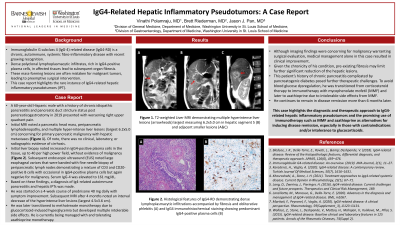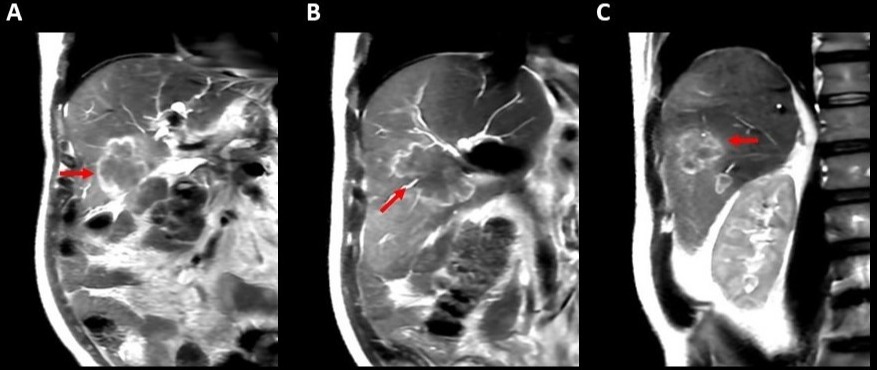Sunday Poster Session
Category: Liver
P1017 - IgG4-Related Hepatic Inflammatory Pseudotumors: A Case Report
Sunday, October 22, 2023
3:30 PM - 7:00 PM PT
Location: Exhibit Hall

Has Audio

Vinathi Polamraju, MD
Washington University in St. Louis
St. Louis, MO
Presenting Author(s)
Vinathi Polamraju, MD, Brett Riederman, MD, Jason J. Pan, MD
Washington University in St. Louis, St. Louis, MO
Introduction: Immunoglobulin G subclass 4 (IgG-4) related disease (IgG4-RD) is a chronic, autoimmune, systemic fibro-inflammatory condition. Hepatic inflammatory pseudotumors (IPTs) are a rare manifestation of IgG4-RD. These mass-forming lesions are often mistaken for malignant tumors, leading to preemptive surgical intervention. Here we present the case of a Hispanic male with IgG4-related hepatic IPTs.
Case Description/Methods: A 60-year-old Hispanic male with a history of chronic idiopathic pancreatitis and pancreatic duct stricture status post pancreaticogastrostomy in 2019 presented with worsening right upper quadrant pain. Initial MRI noted a pancreatic head mass, peripancreatic lymphadenopathy, and multiple hyper-intense liver lesions (largest 6.2x5.0 cm). These findings were concerning for primary pancreatic malignancy with hepatic metastases. Of note, there was no clinical, laboratory, or radiographic evidence of cirrhosis. Initial liver biopsy noted increased IgG-4 positive cells in the tissue, up to 40 per high power field, without evidence of malignancy. Subsequent endoscopic ultrasound (EUS) noted large esophageal varices that were banded with fine needle biopsy of peripancreatic lymph nodes demonstrating a mixture of CD3 and CD20-positive B cells with occasional IgG-4 positive plasma cells but again negative for malignancy. Serum IgG-4 was elevated to 161 mg/dL. Based on these findings, a diagnosis of Ig4-related autoimmune pancreatitis and hepatic IPTs was made. He was started on a 4-week course of prednisone 40 mg daily. Subsequent MRI noted an interval decrease in the hyperintense liver lesions (largest 5.2x3.8 cm).
Discussion: Although imaging findings were concerning for malignancy warranting surgical evaluation, consideration of the overall clinical context, including biopsy, was important for diagnostic confirmation. Medical management alone in this case resulted in clinical improvement. Also, considering the chronicity of his condition, pre-existing fibrosis may limit further significant reduction of the hepatic lesions. This patient’s history of chronic pancreatitis complicated by pancreatogenic diabetes posed further therapeutic challenges. To avoid blood glucose dysregulation, he was transitioned from corticosteroid therapy to immunotherapy with mycophenolate mofetil. Thus, considering the infrequent occurrence of IgG4-related hepatic inflammatory pseudotumors, high clinical suspicion is paramount in order to provide appropriate treatment and avoid unnecessary intervention.

Disclosures:
Vinathi Polamraju, MD, Brett Riederman, MD, Jason J. Pan, MD. P1017 - IgG4-Related Hepatic Inflammatory Pseudotumors: A Case Report, ACG 2023 Annual Scientific Meeting Abstracts. Vancouver, BC, Canada: American College of Gastroenterology.
Washington University in St. Louis, St. Louis, MO
Introduction: Immunoglobulin G subclass 4 (IgG-4) related disease (IgG4-RD) is a chronic, autoimmune, systemic fibro-inflammatory condition. Hepatic inflammatory pseudotumors (IPTs) are a rare manifestation of IgG4-RD. These mass-forming lesions are often mistaken for malignant tumors, leading to preemptive surgical intervention. Here we present the case of a Hispanic male with IgG4-related hepatic IPTs.
Case Description/Methods: A 60-year-old Hispanic male with a history of chronic idiopathic pancreatitis and pancreatic duct stricture status post pancreaticogastrostomy in 2019 presented with worsening right upper quadrant pain. Initial MRI noted a pancreatic head mass, peripancreatic lymphadenopathy, and multiple hyper-intense liver lesions (largest 6.2x5.0 cm). These findings were concerning for primary pancreatic malignancy with hepatic metastases. Of note, there was no clinical, laboratory, or radiographic evidence of cirrhosis. Initial liver biopsy noted increased IgG-4 positive cells in the tissue, up to 40 per high power field, without evidence of malignancy. Subsequent endoscopic ultrasound (EUS) noted large esophageal varices that were banded with fine needle biopsy of peripancreatic lymph nodes demonstrating a mixture of CD3 and CD20-positive B cells with occasional IgG-4 positive plasma cells but again negative for malignancy. Serum IgG-4 was elevated to 161 mg/dL. Based on these findings, a diagnosis of Ig4-related autoimmune pancreatitis and hepatic IPTs was made. He was started on a 4-week course of prednisone 40 mg daily. Subsequent MRI noted an interval decrease in the hyperintense liver lesions (largest 5.2x3.8 cm).
Discussion: Although imaging findings were concerning for malignancy warranting surgical evaluation, consideration of the overall clinical context, including biopsy, was important for diagnostic confirmation. Medical management alone in this case resulted in clinical improvement. Also, considering the chronicity of his condition, pre-existing fibrosis may limit further significant reduction of the hepatic lesions. This patient’s history of chronic pancreatitis complicated by pancreatogenic diabetes posed further therapeutic challenges. To avoid blood glucose dysregulation, he was transitioned from corticosteroid therapy to immunotherapy with mycophenolate mofetil. Thus, considering the infrequent occurrence of IgG4-related hepatic inflammatory pseudotumors, high clinical suspicion is paramount in order to provide appropriate treatment and avoid unnecessary intervention.

Figure: Figure 1. T2-weighted Liver MRI demonstrating multiple hyperintense liver lesions (arrowheads) largest measuring 6.2x5.0 cm in hepatic segment 5 (B) and adjacent smaller lesions (A&C)
Disclosures:
Vinathi Polamraju indicated no relevant financial relationships.
Brett Riederman indicated no relevant financial relationships.
Jason Pan indicated no relevant financial relationships.
Vinathi Polamraju, MD, Brett Riederman, MD, Jason J. Pan, MD. P1017 - IgG4-Related Hepatic Inflammatory Pseudotumors: A Case Report, ACG 2023 Annual Scientific Meeting Abstracts. Vancouver, BC, Canada: American College of Gastroenterology.
